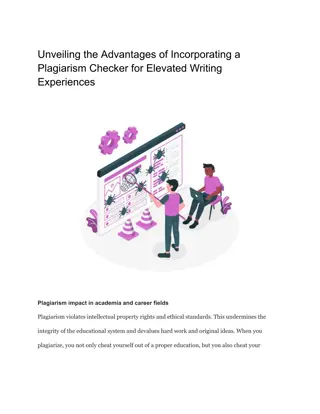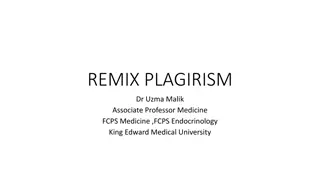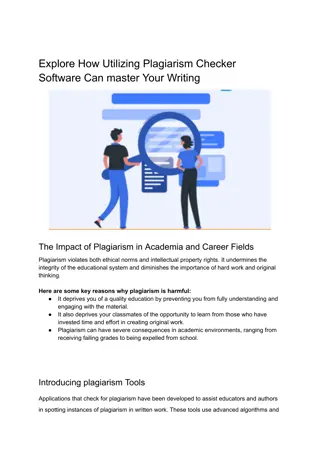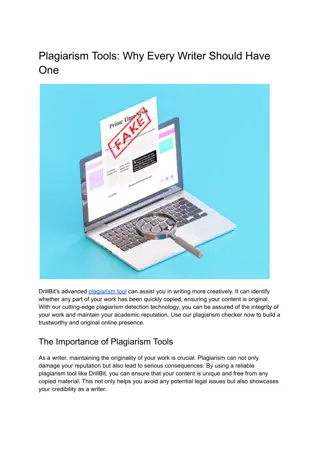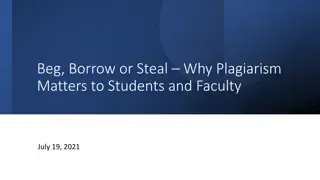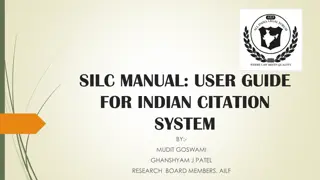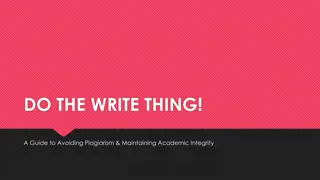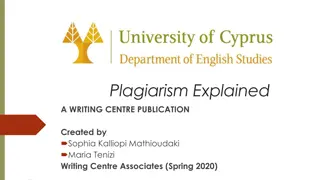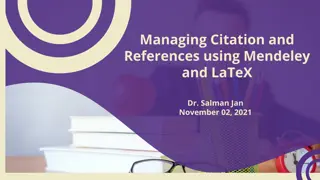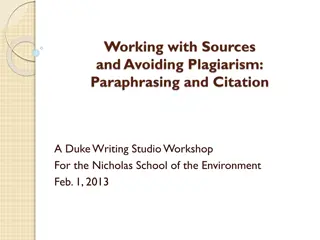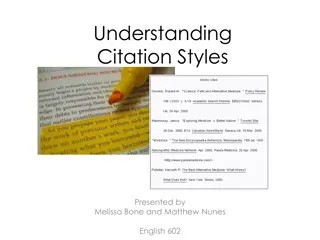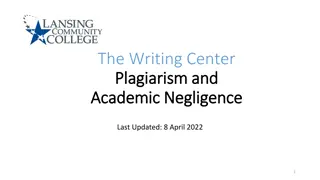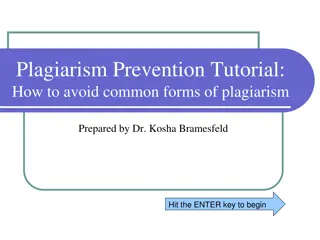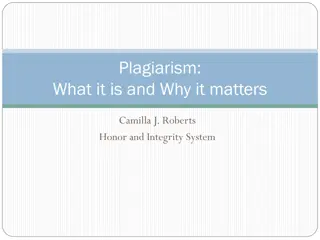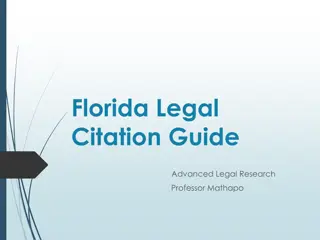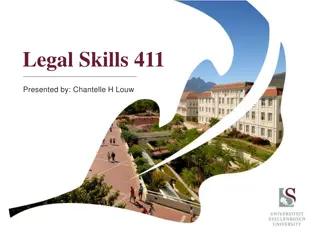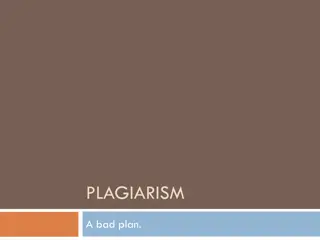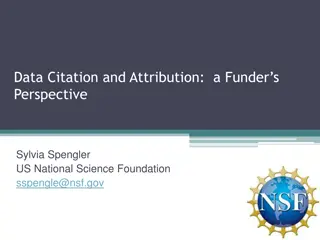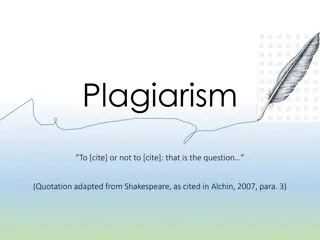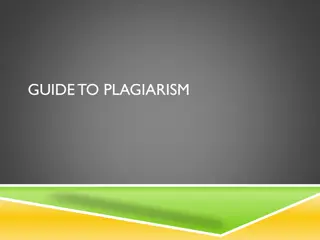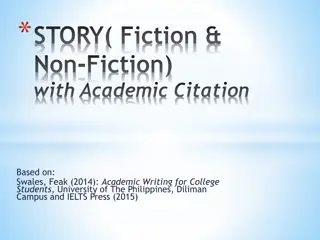Understanding Plagiarism and Proper Citation Techniques
Plagiarism is a serious academic offense that involves using someone else's work without proper acknowledgment. This includes copying text from the internet without citation or failing to use quotation marks when quoting an author. It is important to cite sources correctly, even when summarizing or paraphrasing, to avoid plagiarism.
Download Presentation

Please find below an Image/Link to download the presentation.
The content on the website is provided AS IS for your information and personal use only. It may not be sold, licensed, or shared on other websites without obtaining consent from the author. Download presentation by click this link. If you encounter any issues during the download, it is possible that the publisher has removed the file from their server.
E N D
Presentation Transcript
First Thing First Place your topic choices in the bin In three sentences, write what you learned about the 1930s (or topics) or about using the library for research.
With your table partner Define plagiarism.
What is Plagiarism? The following tutorial was adapted from Robert A. Harris's book The Plagiarism Handbook: Strategies for Preventing, Detecting, and Dealing with Plagiarism, Los Angeles, CA : Pyrczak Publishing, 2001 and is courtesy of University Libraries, The University of Southern Mississippi
True or False? 1. Copying and pasting from the Internet can be done without citing the Internet page, because everything on the Internet is common knowledge and can be used without citation.
FALSE! The correct answer is False because Web pages and other Internet sources are created by an author or authors, which means that if you use something from the Internet, you have to cite it.
True or False? 2. You don't have to use quotation marks when you quote an author as long as you cite the author's name at the end of the paragraph.
FALSE! The correct answer is False because whenever you quote someone else's words you have to designate what they say by using quotation marks to show that you've borrowed it and to set it apart from your own writing.
True or False? 3. When you summarize a block of text from another work, citing the source at the end of your paper is sufficient.
FALSE! The correct answer is False because when you summarize a block of text, you have to cite the source within your paper.
True or False? 4. If you quote your friend in an interview, you don't have to cite him/her or use quotation marks.
FALSE! The correct answer is False because citing a conversation is not different from citing an article or a book. Whenever you quote someone's words, whether they're printed, spoken or sung, you have to cite them.
True or False? 5. You don't have to quote famous sayings because they're common knowledge.
TRUE! The correct answer is True. Proverbs are common knowledge, and therefore don't have to be cited.
TRUE OR FALSE? 6. If you borrow someone's idea and use it in a paper, you don't have to cite it.
FALSE! The correct answer is False because any time you quote, paraphrase or summarize someone else's words or ideas, you have to cite them.
True or False? 7. Using a few phrases from an article and mixing them in with your own words is not plagiarism.
FALSE The correct answer is False because using someone else's words without acknowledging who wrote them-- even when you blend those phrases with your own--is plagiarism.
True or False? 8. Song lyrics don't have to be cited.
False! The correct answer is False because any time you use someone's words or ideas, no matter what the form, you have to cite it.
True or False? 9. The date for George Washington's birthday is common knowledge which means you don't have to cite the source in which you found it.
TRUE The correct answer is True because George Washington's birthdate can be verified in several different sources which means it's common knowledge and you don't have to cite it. If you find the same information in all of your sources, it is common knowledge
What is Plagiarism? Plagiarism is the act of taking another person's writing, conversation, song, or even idea and passing it off as your own. This includes: information from web pages, books, songs, television shows, email messages, interviews, articles, artworks or any other medium.
When Do You Cite Things? Whenever you paraphrase, summarize, or take words, phrases, or sentences from another person's work, it is necessary to indicate the source of the information within your paper using an internal citation. It is not enough to just list the source in a bibliography at the end of your paper. Failing to properly quote, cite or acknowledge someone else's words or ideas with an internal citation is plagiarism.
What is an Internal Citation? An internal, in-text, or parenthetical citation refers to the practice of giving credit to an author, singer, or speaker by citing their words/ideas within your paper. This internal citation is then referenced at the end of your paper in your 'Works Cited' list (see below).
What is a Works Cited Page? A Works Cited page, also known as a bibliography or reference list, comes at the end of your paper listing all the works (books, articles, Internet sites, etc.) you've quoted, paraphrased or otherwise used to create your paper.
What is Common Knowledge? Common knowledge needs no internal citation in a paper. Common knowledge includes information that is considered a well-established fact verifiable in five or more sources. It also includes common sayings and proverbs ("look before you leap") and historical dates, places and events. An example of common knowledge needing no citation: Jane Austen was born in 1775.
Citing Quotations Quoting involves using exact words, phrases and sentences from a source, setting them off with quotation marks, and citing where the information was taken from. Does not have to be what someone has said just something that was written in the text
Paraphrasing and Summarizing Paraphrasing and summarizing are very similar. Both involve taking ideas, words or phrases from a source and crafting them into new sentences within your writing. In addition, summarizing includes condensing the source material into just a few lines. Whether paraphrasing or summarizing, credit is always given to the author.
The House Read The House and underline what you think is important.
The House Read The House with a purpose Burglar Home buyer
Credible Sources How to tell if a website is good to use in your research
If youre using a library database It s a credible source! Just make sure it is relevant and will help further your understanding of your topic The library has a lot of different databases for you to use that s why they re there!
If your first instinct is to go to Google Don t! Google s search results are manipulated by companies who pay to have their websites featured first. Sometimes it s difficult to find an author of a site You spend wayyyyy too much time sifting through information than you should. DO NOT USE WIKIPEDIA! EXCEPTIONS: Mrs. Fox s custom Google search bar OR Google Scholar
How to tell if you have a good source Are the pictures on the page helpful? Is each section of the page labeled with a heading? Did the author sign his/her real name? Did the author give you his/her email address? Is there a date on the page that tells you when it was last updated? If you leave the main page, can you get back to it using the links on the page? Was it easy to find the author s name? Yes = good No = bad
Five Criteria for Evaluating Web Pages #1 Make sure the author provides an email address or a phone number where you can contact him/her. #2 Make sure the author has credentials (a professor, a doctor, a teacher, researcher, etc.) #3 Check out the URL! .edu, .gov, .org are usually credible websites. Steer clear of angelfire, wikispaces, etc.
Five Criteria for Evaluating Web Pages #4 Are there dead links on the page? Has it not been updated in over a year? #5 Is the information cited correctly? Is the article evaluated/reviewed?
What kinds of research am I looking for? Each of you has been provided with three subtopics focus on them Some of the broader topics will have a lot of information You must determine what is and what is not important.


